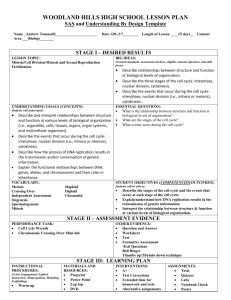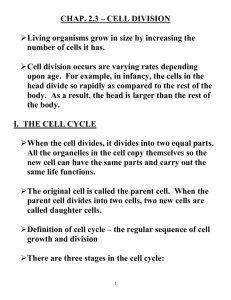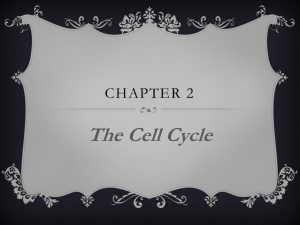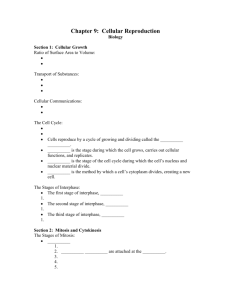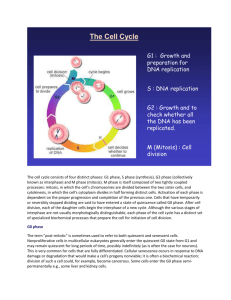Cell Division:
advertisement
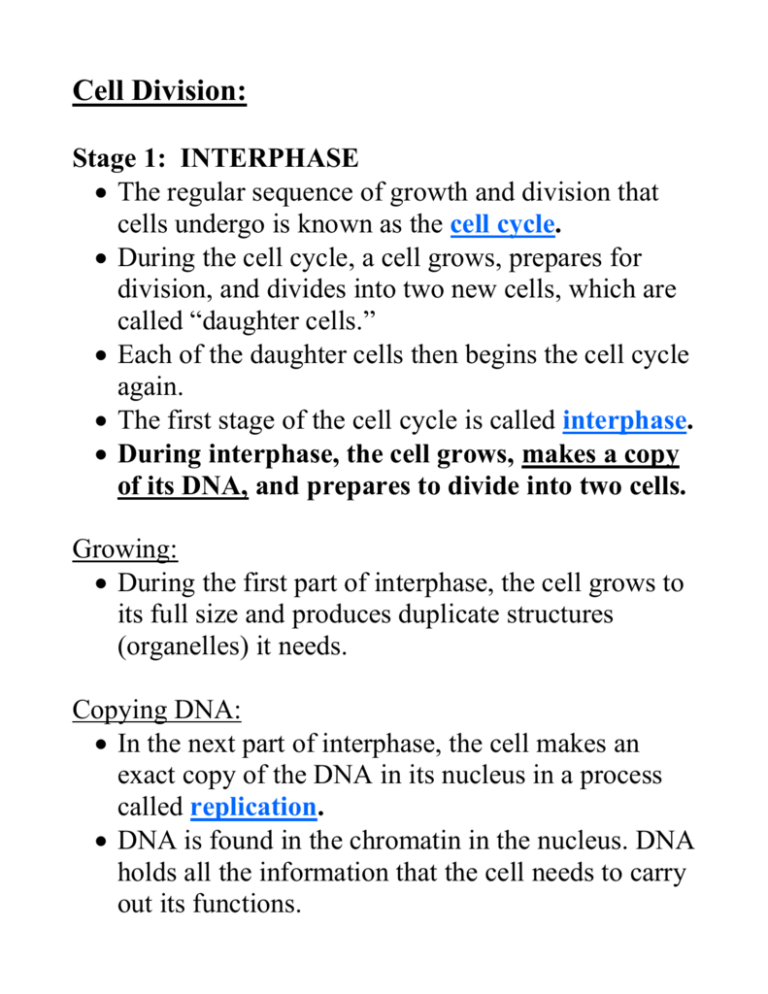
Cell Division: Stage 1: INTERPHASE The regular sequence of growth and division that cells undergo is known as the cell cycle. During the cell cycle, a cell grows, prepares for division, and divides into two new cells, which are called “daughter cells.” Each of the daughter cells then begins the cell cycle again. The first stage of the cell cycle is called interphase. During interphase, the cell grows, makes a copy of its DNA, and prepares to divide into two cells. Growing: During the first part of interphase, the cell grows to its full size and produces duplicate structures (organelles) it needs. Copying DNA: In the next part of interphase, the cell makes an exact copy of the DNA in its nucleus in a process called replication. DNA is found in the chromatin in the nucleus. DNA holds all the information that the cell needs to carry out its functions. Preparing for Division: Once the DNA has replicated, preparation for cell division begins. At the end of interphase, the cell is ready to divide. Stage 2: MITOSIS Once interphase is complete, the second stage of the cell cycle begins. Mitosis is the stage during which the cell’s nucleus divides into two new nuclei. During mitosis, one copy of the DNA is distributed into each of the two daughter cells. (Video Clip) Mitosis is divided into four phases: prophase, metaphase, anaphase, and telophase. Chromatin in the nucleus condenses to form double-rod structures called chromosomes. Looks like an “X”. Each chromosome has two rods because the cell’s DNA has replicated, and each rod in a chromosome is an exact copy of the other. Each identical individual rod in a chromosome is called a chromatid, while together the two chromatids are called chromosomes. Stage 3: CYTOKINESIS The final stage of the cell cycle, which is called cytokinesis completes the process of cell division. During cytokinesis, the cytoplasm divides. The organelles are distributed into each of the two new cells. When cytokinesis is complete, two new cells, or daughter cells, have formed. Each daughter cell has the same number of chromosomes as the original parent cell. At the end of cytokinesis, each cell enters interphase, and the cycle begins again. Structure and Replication of DNA DNA replication ensures that each daughter cell will have the genetic information it needs to carry out its activities. The Structure of DNA: A DNA molecule looks like a twisted ladder, or spiral staircase. The two sides of the DNA ladder are made up of molecules of a sugar called deoxyribose, alternating with molecules known as phosphates. Each rung is made up of a pair of molecules called nitrogen bases. DNA has four kinds of nitrogen bases that pair up on the “ladder”. The bases on one side of the ladder pair with the bases on the other side. Adenine (A) only pairs with thymine (T), while guanine (G) only pairs with cytosine (C). Review Questions: 1. What are the three stages of the cell cycle? - Interphase, Mitosis, Cytokinesis. 2. What are the additional phases of Mitosis? - Prophase, metaphase, anaphase, telophase (PMAT). 3. After cytokinesis, what is the term for each new cell? - Daughter cell. 4. List the nitrogen bases in DNA and who pairs with who? - Adenine pairs with Thymine, Guanine pairs with Cytosine (AT,GC). 5. One section of a strand of DNA has the base sequence AGATTC. What is the base sequence on the other strand it would be paired with? - TCTAAG
